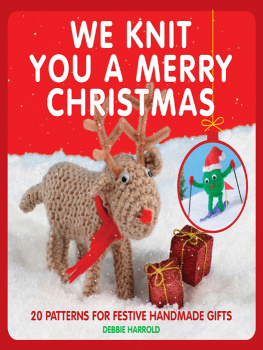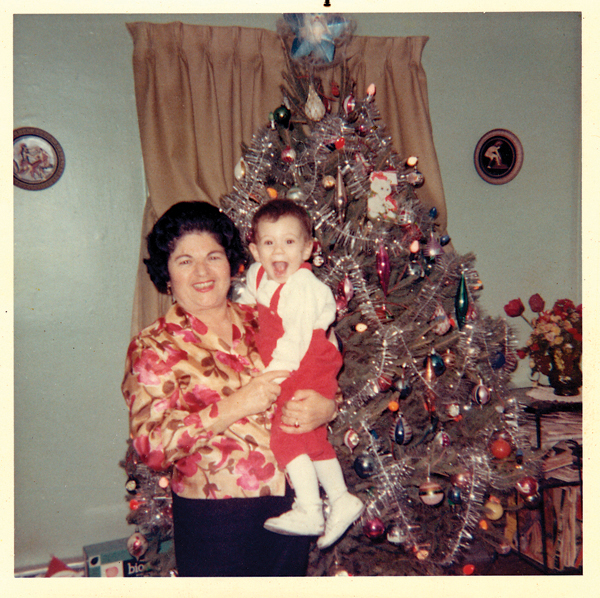

 Contents
Contents
Introduction C hristmastime seems to bring back fond memories and an appreciation for tradition in all of us. How many things do we do at Christmas just because we have always done them? Baking cookies, hanging stockings, and trimming the tree come to mind, though each family has its own variations on these traditions that make them unique. One of my favorite parts of decorating for Christmas is pulling out and hanging each ornament on the tree. Every one has a story, and remembering those stories and people brought to mind by the ornaments is part of the tradition. This book was crafted with those familiar traditions in mind. Each pattern was chosen for its heirloom potential.
Many of the patterns are, in fact, vintage patterns reworked in modern knitting pattern style. Others were chosen because they could just as well have been knitted a hundred years ago and still maintain their relevance and charm. Line your mantle with stockings, hang a Woodland Wreath, trim your tree with Colorwork Ornaments, and wake up on Christmas morning and put on your Scandinavian Star Slippers. While you are knitting, make some giftsthe Holly Hat for that special little girl, the childrens slippers or Santa Booties for baby, and a hobby horse for your adventurous one. All of the items in this book are sure to be treasured, becoming a part of your own Christmas story. Candi Derr, Editor
I would describe most of the patterns in this book as for the advanced beginner to experienced knitter.
Skill levels are not given; instead, I encourage you to evaluate each pattern and compare the skills needed and techniques used to your own experience. Pay particular attention to the Special Techniques and Notes at the beginning of each pattern. These will describe the construction of the piece and any special stitches or knowledge needed to complete the pattern. Then decide if a pattern suits your abilities. Techniques used include knitting in the round, stranded knitting, intarsia, seaming, and sewing, among others. This book assumes knowledge of these techniques, and as this instruction is readily available elsewhere, it is not included here.
Ill describe some of the most used techniques and knowledge needed as a quick refresher, but if you have never used these techniques before, then I recommend referencing an instruction book or going online. A quick search will turn up many excellent tutorials and videos showing just what you need. Practice with scrap yarn before beginning your project. Dont let fear of a new technique hold you back. If you love a project, give it a try and add to your knitting repertoire!
Intarsia
Intarsia is what we call it when you knit in large blocks of color where the colors are too far apart to carry a strand of yarn from one place in a row in which it is used to another. Instead, you knit with several small balls of yarn, dropping and picking up colors as needed across a row.
The only thing to remember here is that each time you drop one strand and pick up another, you must bring the new color around the old one to prevent a hole in your knitting at the color change. Before you begin your project, separate your yarn into smaller balls to work from. You may wrap these around yarn bobbins if you like, or simply work from the balls. When youve got lots of yarn balls going at once, they will get tangled, so stop frequently to untangle them. It may be helpful to work at a table, where it will be easier to keep them in order as you work.
Stranded Colorwork Knitting
Stranded colorwork is used when the color changes are close together, such as in the Norwegian Flowers stocking, and for lettering.
It is almost always worked in the round and with only two colors per row. The general rule is that you can carry a strand (float) for five stitches or fewer; otherwise, you should start another ball for the new color and work it intarsia. To switch colors, drop the old color and pick up the new one, always keeping one color above the other, i.e., always picking up Color A over Color B and Color B under Color A.
Reading Charts
Many of the patterns in this book include color charts. These should be worked as instructed in the pattern, working back and forth across the chart if you are working a flat piece, and every row from right to left when working in the round. The color of each square (following the chart key) indicates which color that stitch is to be worked in.
The charts also show shapingincreases and decreases. In other words, if the row you are working is starting a stitch shorter than the row before, then you need to work a decrease at the beginning of the row and, conversely, if it is longer, you need to work an increase. The pattern will instruct you as to how these increases and decreases should be worked.
Lettering
Many of the stockings have space at the top for a name or holiday greeting. Two complete alphabet charts have been included, which correspond as noted to the stocking patterns. You may choose the letters you want, chart them onto the existing pattern chart, and then work them either as stranded knitting as you go, or at the end in duplicate stitch.
To work duplicate stitch, bring a needle threaded with yarn up through the point of the V in the first stitch you want to duplicate and pull the yarn through, leaving a few inches of yarn at the back of the work to weave in later. Take the needle behind the V of the stitch above the stitch you are duplicating (from right to left) and pull the yarn through. Then take the needle back through the point at which you started to complete the V. Repeat for as many stitches as you wish to duplicate.
Seaming
Sometimes the preferred seaming technique will be specified in the pattern.
Sewing and Embroidery
There is some basic sewing involved for attaching pieces, such as for the Woodland Wreath and Poinsettia Pillow, and some basic embroidery for adding embellishments.
Sewing and Embroidery
There is some basic sewing involved for attaching pieces, such as for the Woodland Wreath and Poinsettia Pillow, and some basic embroidery for adding embellishments.
For attaching pieces, a basic whipstitch will usually suffice. If something more specific is recommended, it will be given in the instructions. Consult the project photos, as well, for placement.
YARN Plymouth Encore DK, light weight #3 yarn (75% acrylic, 25% wool; 150 yd./137 m per 1.7 oz./50 g skein) 1 skein Taupe (Color A) 1 skein Burgundy (Color B) 1 skein Olive Green (Color C) 1 skein Forest Green (Color D) 1 skein Black (Color E) 1 skein Light Brown (Color F) NEEDLES AND OTHER MATERIALS US 5 (3.75 mm) straight needles Tapestry needle Decorative cord or yarn for hanging Stitch holder or waste yarn Optional: bobbins for working intarsia MEASUREMENTS 5 19"/13 48 cm GAUGE 24 sts 32 rows = 4"/10 cm square Adjust needle size if necessary to obtain gauge. SPECIAL TECHNIQUES Kitchener Stitch Hold the stitches for the instep on one needle and the stitches for the sole on a second needle. Thread the yarn (about 15"/38 cm) on a tapestry needle.
Next page















 Contents
Contents




